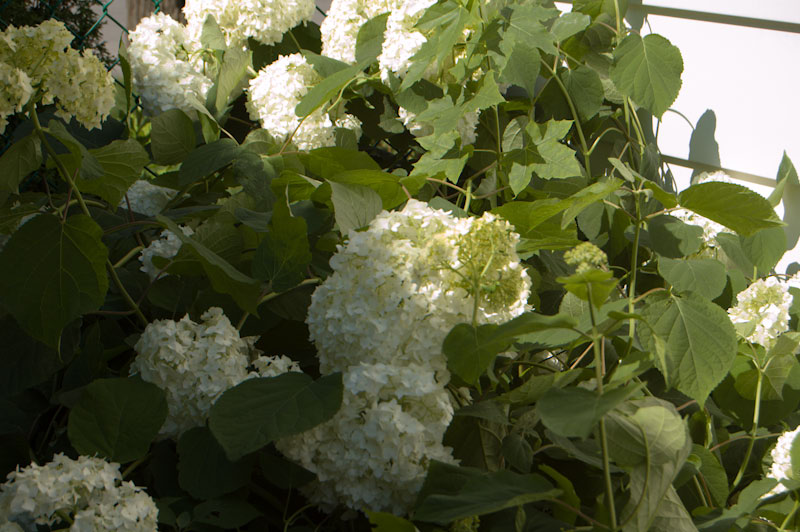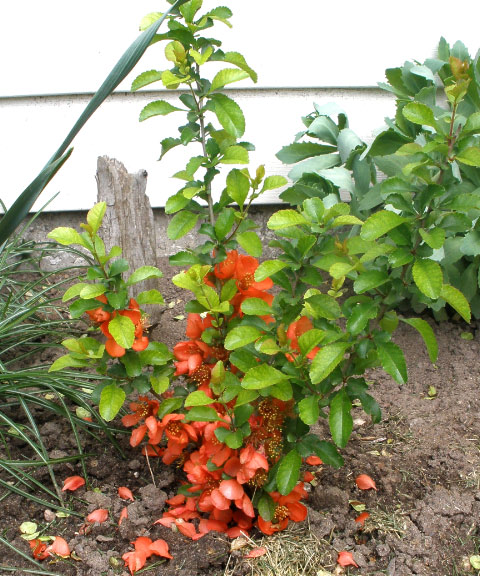My garden plants.

Gardening -- Plants currently in my garden.
Shrubs.
(Note: Click on any image thumbnail for a larger photo which opens in a separate tab.)
- Boxwood Green velvet – Buxus x 'Green Velvet'.
- Description: Small, dark green foliage maintains its colour year round. Shear annually to maintain shape. Extremely hardy. Ideal small formal hedge or garden border planting. Grows up to three feet (1 m) tall and three feet (1 m) wide.
- Observations: Two of these plants were placed in my north-facing foundation garden and seem to be doing well. Staying green all winter is a treat, especially when there is not a lot of snow like the winter of 2006-2007.
- Growing preferences: Full sun to part shade in well-drained soil rich in organic matter. A 2-3" (5-8 cm) layer of mulch is beneficial. Adaptable to many soil conditions. Does best with cool moist roots. Winter snow cover is recommended.
- Zone: 4B-9.
- Year added: 2005 (May).
- Plant source: Loblaws garden centre.
- Links to further info: Boxwood in the Landscape, Virginia Cooperative Extension
- Photo(s):
- Common lilac.
- Description: Delightful fragrant mauve (light and dark) flowers. Spreads rapidly, needs ample room. Good in shrub border, or alone. 6-10' (2-3 m).
- Growing preferences: Well drained soil. Sun or half-shade.
- Observations: Many publications recommend cutting out one-third of the stalks each year once the plant has reached early maturity. This can seem drastic but it is necessary and contributes to the health and look of the plant. Pruning should be done soon after blooming is complete in the late spring. For some time I trimmed all the dead blooms off the plants, being careful not to cut into the growth tip for next year. I am not sure if this improved blooming. I have found the shrubs provide more blooms on alternate years than the intervening year. The shrubs produce abundant suckers which I cut out at least once a year.
- Zone: 2b-9.
- Year added: The three shrubs were well established on the property when I moved into the house in 1973. One plant was dug up and moved several years later and adapted well.
- Plant source: Unknown.
- Links to further info:
- Photo(s):
 In
spring bloom.
In
spring bloom.
- Winged Burning Bush – Euonymus Alatus.
- Description: A multi-stemmed deciduous shrub with a more or less rounded form. Has green foliage throughout the season with the pointy leaves turning an outstanding red in the fall. The flowers are not ornamentally significant. Produces red capsules from early to late fall. The bark is extremely showy and adds significant winter interest. Very adaptable and versatile. Prune in early spring (March). Mature at 10 feet (3 m) tall and a spread of 10 feet (3 m). Grows at a slow rate. Water well before winter dormancy.
- Growing preferences: Full sun to full shade.
- Observations: This bush is famous for the flaming red leaves in the fall. The winged bark on the stems also makes it attractive in winter when the leaves have fallen off. Needs regular pruning. Birds, especially the cardinals, enjoy the berries over the winter.
- Zone: 3
- Year added: 2006.
- Plant source: Peter Knippel Nursery.
- Links to further info: http://www.hcs.ohio-state.edu/hcs/TMI/PlantList/eu_alata.html
- Photo(s):
- Emerald Gaiety Euonymus – Euonymus fortunei 'Emerald
Gaiety'.
- Description: A supremely attractive mounded shrub featuring pronounced white-variegated evergreen leaves. Deep green leaves edged in white become pink fringed in winter. Can also climb if given support. Excellent small hedge or foundation planting. Grows 4 feet (3.2 m) tall and 4 feet (3.2 m) wide. (Source: the tag on the plant when purchased.)
- Growing preferences: Full sun to shade.
- Observations: Purchased two of these for the north-facing front foundation garden. They took readily and were starting to spread by fall. Easily pruned. When moving the plants during construction in 2007 a section of one plant broke off and was transplated separately. This grew very well with no die-back.
- Zone: 5-9
- Year added: 2005 (May).
- Plant source: Loblaws garden centre.
- Link to further info: http://northscaping.com/Tools/LandscapePlantSearch.asp?1747
- Photo(s):
- Hydrangea – Annabelle.
- Description: Stunning, big, ball-shaped flower heads on strong branches with deep green foliage. The blooms give it a common name of Snowball. Blooms from July to heavy frost. Heavy pruning in fall or early spring (cut low to the ground) creates fewer, but larger blooms. Light pruning in early spring (cut back one third or less) creates numerous, smaller blooms. Dried blooms turn brown and are good for dry flower arrangements. Each year (fall or early spring) it is advisable to clear out dead, misformed or bent stalks. This gives a neater appearance. 18-24" (45-60 cm).
- Growing preferences: Sun or partial shade.
- Zone: 3b-9.
- Year added: The collection of shrubs was well established on the property when I moved into the house in 1973.
- Plant source: Unknown.
- Links to further info:
- Photo(s):
- Meadowsweet – Filipendula. (AKA Spiraea ulmaria (L.),
Bridewort, meadow queen, meadow-wort, pride of the meadow, queen of the
meadow, lady of the meadow, dollof, meadsweet.)
- Description: Perennial herb, growing in damp meadows, ditches and bogs, at the edges of ponds, on river banks and in damp open woodland. The creeping rootstock sends up a reddish, angular stem, up to 48" (120cm) tall or more, branched near the top and bearing alternate long-petioled leaves composed of two to five pairs of ovate, serrate leaflets which are widely tomentose beneath. The small, creamy-white five-petalled flowers with over twenty protruding stamens grow in panicled cymes from June to August. Clusters of pink or white flowers in early or middle summer on plants with attractive compound leaves. Meadowsweet seeds itself freely, but can also be propagated by root division in autumn or spring. Pick flowers before they are fully open for long-lasting bouquets. Does not do well where summers are hot and dry.
- Growing preferences: Full sun or light shade.
- Observations: The plant did not do much the first year it was planted, which is not unusual. The second year is grew very tall and branched out significantly. It also bloomed nicely. As it was too crowded in the space, I moved it in the fall of 2006 (September) to a bright, sunny location where it had more room. It grew well in the 2007 season.
- Zone: 2-9.
- Year added: 2005 (June).
- Plant source: Fletcher Wildlife Garden plant exchange.
- Links to further info:
- Photo(s):
- Chaenomeles japonica - Japanese flowering quince.
- Description: A small, spreading shrub with dramatic orange-red to pink flowers all along the stems in late spring (May). The fruit resembles an miniature yellowish-green apple, but it isn't particularly edible without processing into jams, juices, jellies or liquers.
- Growing preferences: Full sun. Very deep-rooted.
- Observations: This specimen may be Chaenomeles xsuperba, a hybrid of the Japanese C. japonica.
- Zone:
- Year added:
- Plant source:
- Links to further info: http://homepage3.nifty.com/plantsandjapan/page015.html
- Photo(s):
Date of last revision:
2019-12-16.
Material Copyright © 2019 David Darwin














